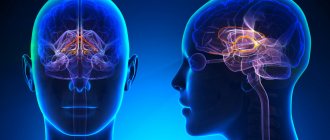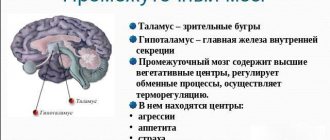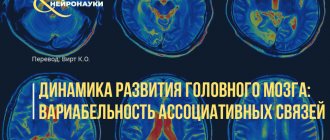Man is the only species on earth that, in addition to satisfying the needs dictated by instincts, is capable of carrying out emotional, creative and mental activities. The uniqueness of people lies in the presence of extensive, highly developed and complexly constructed areas of the brain, which have the general name neocrtex. Therefore, in the study of man, as a species at the upper stage of evolution, the main directions are questions about the structure and functions of this part of the central nervous system.
General information
The neocortex (new cortex, isocortex or lat. neocortex) is an area of the cerebral cortex, occupying about 96% of the surface of the hemispheres and having a thickness of 1.5 - 4 mm, which are responsible for the perception of the surrounding world, motor skills, thinking and speech.
The neocortex consists of three main types of neurons - pyramidal, stellate and fusiform. The first, the most numerous group, which makes up about 70-80% of the total amount in the brain. The proportion of stellate neurons is at the level of 15-25%, and fusiform neurons - about 5%.
In its structure, the neocortex is almost homogeneous and consists of 6 horizontal layers and vertical columns of the cortex. The layers of the new cortex have the following structure:
- Molecular, consisting of fibers and a small number of small stellate neurons. The fibers form a tangential plexus.
- The outer granular layer is formed by small neurons of various shapes, which are connected to the molecular layer over the entire area. At the very end of the layer there are small pyramidal cells.
- External pyramidal, consisting of small, medium and large pyramidal neurons. The processes of these cells can be associated with both layer 1 and the white matter.
- Internal granular, which consists mainly of stellate cells. This layer is characterized by a loose arrangement of neurons.
- Internal pyramidal, formed by medium and large pyramidal cells, the processes of which are connected with all other layers.
- Polymorphic, the basis of which is made up of spindle-shaped neurons, connected by processes with layer 5 and white matter.
In addition, the neocortex is divided into areas, which in turn are subdivided into Brodmann areas. The following areas are distinguished:
- Occipital (17,18 and 19 fields).
- Superior parietal (5 and 7).
- Inferior parietal (39 and 40).
- Postcentral (1, 2, 3 and 43).
- Precentral (4 and 6).
- Frontal (5, 9, 10, 11, 12, 32, 44, 45, 46 and 47).
- Temporal (20, 21, 22, 37, 41 and 42).
- Limbic (23, 24, 25 and 31).
- Ostrovkovaya (13 and 14).
The cortical columns are a group of neurons that are located perpendicular to the cerebral cortex. Within a small column, all cells perform the same task. But a hypercolumn, consisting of 50-100 mini-columns, can have one or many functions.
What functions does the neocortex perform?
Neocortex, or gray matter
The neocortex contains over fifteen billion neurons (nerve cells) - and each such cell has the capabilities of a computer. It is thanks to their incredible properties that we can move around, communicate with people, store a bunch of information in memory that can be used at the right time - numbers, phone numbers, addresses, dates, as well as a huge vocabulary, the taste of various foods, various sounds and etc.
The neocortex consists of two cerebral hemispheres: the right and left.
In short, the left hemisphere of the brain is responsible for the rational - for example, reading, speaking, counting, reasoning, analyzing a situation, making connections. It is associated with logical thinking and corresponds to the giving masculine principle, yang. It controls the right side of our body.
The right hemisphere processes information about emotions and feelings. Thanks to him, we understand the situation and give it an emotional or sensory coloring (what we feel). It is associated with imagination, intuition, and also with dreams. It is responsible for our receptive feminine principle, yin, and governs the left side of the body.
The two hemispheres are connected by the corpus callosum, through which they can exchange information. For example: the phone rings, I answer. The right hemisphere allows me to recognize the caller's voice and determine whether he is calm or worried. I can talk to this person using the left hemisphere. If a stranger calls, based on the tone of his voice and based on my feelings (right hemisphere), I will treat him with sympathy or antipathy.
The interaction of the two hemispheres of the brain and the conclusion they come to will determine my actions: will I continue the conversation or hang up the phone.
Thus, the neocortex performs the following functions:
1. Acceptance of information.
2. Analysis and reasoning (left hemisphere), general perception and sensation (right hemisphere).
3. Memorizing facts and knowledge: colors, letters of the alphabet, numbers, arts and sciences, etc.
The neocortex is the seat of intelligence. Its main role is recognition, it is thanks to it that we can make choices every day. And depending on a favorable or unfavorable choice, an experience is formed that allows us to grow spiritually.
Functions of neocortex
The new cortex is responsible for performing higher nervous functions (thinking, speech, processing information from the senses, creativity, etc.). Clinical trials have shown that each area of the cerebral cortex is responsible for strictly defined functions. For example, human speech is controlled by the left frontal gyrus. However, if any of the areas is damaged, the neighboring one can take over its function, although this requires a long period of time. Conventionally, there are three main groups of functions performed by the neocortex - sensory, motor and associative.
Sensory
This group includes a set of functions with the help of which a person is able to perceive information from the senses.
Each sense is analyzed by a separate area, but signals from others are also taken into account.
Signals from the skin are processed by the posterior central gyrus. Moreover, information from the lower extremities goes to the upper part of the gyrus, from the body to the middle part, from the head and hands to the lower part. In this case, the posterior central gyrus processes only pain and temperature sensations. The sense of touch is controlled by the superior parietal region.
Vision is controlled by the occipital region. Information is received in field 17, and in fields 18 and 19 it is processed, that is, color, size, shape and other parameters are analyzed.
Hearing is processed in the temporal region.
Charm and taste sensations are controlled by the hippocampal gyrus, which, unlike the general structure of the neocortex, has only 3 horizontal layers.
It is worth noting that in addition to the zones of direct reception of information from the senses, next to them there are secondary ones, in which the relationship between the received images and those stored in memory occurs. When these areas of the brain are damaged, a person completely loses the ability to recognize incoming data.
Motor
This group includes the functions of the neocortex, with the help of which any movement of the human limbs is carried out. Motor skills are controlled and controlled by the precentral region. The lower limbs depend on the upper parts of the central gyrus, and the upper limbs depend on the lower ones. In addition to the precentral, the frontal, occipital and superior parietal regions are involved in movement. An important feature of the performance of motor functions is that they cannot be performed without constant connections with sensory areas.
Associative
This group of neocortical functions is responsible for such complex elements of consciousness as thinking, planning, emotional control, memory, empathy and many others.
Associative functions are performed by the frontal, temporal and parietal regions.
In these areas of the brain, a reaction to data coming from the senses is formed and command signals are sent to the motor and sensory areas.
To receive and control, all sensory and motor areas of the cerebral cortex are surrounded by associative fields, in which the received information is analyzed. But at the same time, it is worth considering that the data coming into these fields is already primarily processed in the sensory and motor areas. For example, if there is a disruption in the functioning of such an area in the visual area, a person sees and understands that there is an object, but cannot name it and, accordingly, make a decision about his further behavior.
In addition, the frontal lobe of the cortex is very tightly connected to the limbic system, which allows it to control and manage emotional messages and reflexes. This makes it possible for a person to develop as a person.
The performance of associative functions in the neocortex is possible due to the fact that the neurons of this part of the central nervous system are able to retain traces of excitation based on the feedback principle and can persist for a long time (from several years to a lifetime). This ability is memory, with the help of which associative connections of the information received are built.
Limbic system
The limbic system of the brain is a set of complex neuroregulatory structures of the brain. This system is not limited to just a few functions - it performs a huge number of tasks that are essential for humans. The purpose of the limbus is the regulation of higher mental functions and special processes of higher nervous activity, ranging from simple charm and wakefulness to cultural emotions, memory and sleep.
History of origin
The limbic system of the brain formed long before the neocortex began to form. This is the oldest hormonal-instinctive structure of the brain, which is responsible for the survival of the subject. Over a long period of evolution, 3 main goals of the system for survival can be formed:
- Dominance is a manifestation of superiority in a variety of ways
- Food - Subject's nutrition
- Reproduction - transferring your genome to the next generation
Because man has animal roots, the human brain has a limbic system. Initially, Homo sapiens possessed only affects that influenced the physiological state of the body. Over time, communication developed using the type of scream (vocalization). Individuals who were able to convey their state through emotions survived. Over time, the emotional perception of reality was increasingly formed. This evolutionary layering allowed people to unite into groups, groups into tribes, tribes into settlements, and the latter into entire nations. The limbic system was first discovered by American researcher Paul McLean back in 1952.
System structure
Anatomically, the limbus includes areas of the paleocortex (ancient cortex), archicortex (old cortex), part of the neocortex (new cortex) and some subcortical structures (caudate nucleus, amygdala, globus pallidus). The listed names of the various types of bark indicate their formation at the indicated time of evolution.
A lot of specialists in the field of neurobiology have been studying the question of which structures belong to the limbic system. The latter includes many structures:
Cortical structures:
- cingulate gyrus;
- hippocampus;
- ribbon gyrus;
- parahippocampal gyrus;
- dentate gyrus.
Subcortical structures:
- amygdala;
- nuclei of the septum pellucidum;
- mastoid bodies;
- central gray matter of the cerebral aqueduct;
- olfactory bulb, triangle and olfactory tract;
- anterior and medial nuclei of the optic tubercle;
- leash cores;
- midbrain nucleus;
- collector system of pathways that provide connections between the structures of the visceral brain.
In addition, the system is closely related to the reticular formation system (the structure responsible for brain activation and wakefulness). The anatomy of the limbic complex is based on the gradual layering of one part onto another. So, the cingulate gyrus lies on top, and then descending:
- corpus callosum;
- vault;
- mamillary body;
- amygdala;
- hippocampus
A distinctive feature of the visceral brain is its rich connection with other structures, consisting of complex pathways and two-way connections. Such a branched system of branches forms a complex of closed circles, which creates conditions for prolonged circulation of excitation in the limbus.
Functionality of the limbic system
The visceral brain actively receives and processes information from the surrounding world. What is the limbic system responsible for? The limbus is one of those structures that works in real time, allowing the body to effectively adapt to environmental conditions.
The human limbic system in the brain performs the following functions:
- Formation of emotions, feelings and experiences. Through the prism of emotions, a person subjectively evaluates objects and environmental phenomena.
- Memory. This function is carried out by the hippocampus, located in the structure of the limbic system. Mnestic processes are ensured by reverberation processes - a circular movement of excitation in the closed neural circuits of the seahorse.
- Selecting and correcting a model of appropriate behavior.
- Training, retraining, fear and aggression;
- Development of spatial skills.
- Defensive and foraging behavior.
- Expressiveness of speech.
- Acquisition and maintenance of various phobias.
- Function of the olfactory system.
- Reaction of caution, preparation for action.
- Regulation of sexual and social behavior. There is a concept of emotional intelligence - the ability to recognize the emotions of others.
When expressing emotions , a reaction occurs, which manifests itself in the form of: changes in blood pressure, skin temperature, breathing rate, pupil reaction, sweating, reaction of hormonal mechanisms and much more.
Perhaps there is a question among women about how to turn on the limbic system in men. However, the answer is simple: not at all. In all men, the limbus works fully (with the exception of patients). This is justified by evolutionary processes, when a woman in almost all time periods of history was engaged in raising a child, which includes a deep emotional return, and, consequently, a deep development of the emotional brain. Unfortunately, men can no longer achieve the development of limbus at the level of women.
The development of the limbic system in an infant largely depends on the type of upbringing and the general attitude towards it. A stern look and a cold smile do not contribute to the development of the limbic complex, unlike a tight hug and a sincere smile.
Interaction with the neocortex
The neocortex and limbic system are tightly connected through many pathways. Thanks to this unification, these two structures form one whole of the human mental sphere: they connect the mental component with the emotional one. The neocortex acts as a regulator of animal instincts: before committing any action spontaneously caused by emotions, human thought, as a rule, undergoes a series of cultural and moral inspections. In addition to controlling emotions, the neocortex has an auxiliary effect. The feeling of hunger arises in the depths of the limbic system, and the higher cortical centers that regulate behavior search for food.
The father of psychoanalysis, Sigmund Freud, did not ignore such brain structures in his time. The psychologist argued that any neurosis is formed under the yoke of suppression of sexual and aggressive instincts. Of course, at the time of his work there was no data on the limbus, but the great scientist guessed about similar brain devices. Thus, the more cultural and moral layers (super ego - neocortex) an individual had, the more his primary animal instincts (id - limbic system) are suppressed.
Violations and their consequences
Based on the fact that the limbic system is responsible for many functions, this very many can be susceptible to various damages. The limbus, like other structures of the brain, can be subject to injury and other harmful factors, which include tumors with hemorrhages.
Syndromes of damage to the limbic system are rich in number, the main ones are:
Dementia is weak-mindedness. The development of diseases such as Alzheimer's and Pick's syndrome is associated with atrophy of the limbic complex systems, and especially in the hippocampus.
Epilepsy . Organic disorders of the hippocampus lead to the development of epilepsy.
Pathological anxiety and phobias. Disturbance in the activity of the amygdala leads to a mediator imbalance, which, in turn, is accompanied by a disorder of emotions, which includes anxiety. A phobia is an irrational fear of a harmless object. In addition, an imbalance of neurotransmitters provokes depression and mania.
Autism . At its core, autism is a deep and serious maladjustment in society. The inability of the limbic system to recognize the emotions of other people leads to serious consequences.
The reticular formation (or reticular formation) is a nonspecific formation of the limbic system, responsible for the activation of consciousness. After deep sleep, people wake up thanks to the work of this structure. In cases of its damage, the human brain is subject to various disorders of blackout, including absence and syncope.
The role of the neocortex in emotions and stereogynesis
Emotions in humans initially appear in the limbic system of the brain. But in this case they are represented by primitive concepts, which, once in the new cortex, are processed using the associative function. As a result, a person can operate with emotions at a higher level, which makes it possible to introduce concepts such as joy, sadness, love, anger, etc.
The neocortex also has the ability to dampen strong outbursts of emotion in the limbic system by sending calming signals to areas of high neuronal excitability. This leads to the fact that in a person the dominant role in behavior is played by the mind, and not by instinctive reflexes.
The neocortex is what makes a person human
Neocortex is a nice word. But what does it mean translated from Latin? Probably each of us in childhood, for diarrhea and intestinal upset, took a herbal astringent and fixative - oak bark, or Cortex Querkus. Cortex – means “bark”, cortical substance. Well, “neo” means new, and only in the Wachowski brothers’ film “The Matrix” the character’s name “Neo” has a different, sacred meaning – “the chosen one.”
Neocortex, neocortex is the new human cerebral cortex. In a sense, its significance for our civilization is truly chosen. Another name for it is the cloak, pallium, or isocortex. It covers with a uniform gray cloak all the white matter of the cerebral hemispheres, which are conductive pathways, “wires”, deprived of the independent ability to generate impulses. When the term brain is used, it is this part of the central nervous system that is meant.
The name isocortex - isos - identical, equal - indicates that the entire brain is covered with a cortex of approximately the same thickness, consisting of six layers of neurons. This system occupies a larger area than can be occupied if it were smooth, so the isocortex forms grooves and convolutions.
Differences from old bark
The old cortex (archicortex) is an earlier emerging part of the cerebral cortex than the neocortex. But in the process of evolution, the new cortex became more developed and extensive. In this regard, the archicortex ceased to play a dominant role and became one of the constituent parts of the limbic system.
If we compare the old one in terms of the functions performed, then the first is assigned the role of fulfilling innate reflexes and motivation, and the second - managing emotions and actions at a higher level.
In addition, the neocortex is significantly larger in size than the old cortex. So the first occupies about 96% of the total surface of the hemispheres, and the size of the second is no more than 3%. This ratio shows that the archicortex cannot perform higher nervous functions.
Neocortex - rational brain
Hide advertisements in article
Neocortex - rational brain
The newest outer part of the brain is the neocortex, or rational brain. It is the pinnacle of brain evolution and the seat of free will and conscious awareness. It is responsible for our higher cognitive functions (speech, writing, problem solving), and also controls analytical and mathematical thinking. The neocortex, also called the neocortex, or simply the cortex for short, is made up of numerous folds and grooves divided into the right and left hemispheres. The right hemisphere is responsible for spatial imagination, creativity and abstract thinking, while the left hemisphere thinks more linearly, rationally, using words. The emotional brain determines significance, and the neocortex gives rational meaning to the feelings and emotions generated by the deeper, subconscious parts of the brain, trying to explain the causes and consequences of our sensations.
MacLean called the cerebral cortex “the mother of creativity and the father of abstract thinking.” This part of the brain includes the prefrontal cortex, the most developed and complex part of the brain, which distinguishes humans from other living things. The prefrontal cortex gives us the ability to plan behavior or create new possibilities by functioning as a mental stimulator of different realities, thanks to which we can imagine and anticipate the consequences of our actions. The prefrontal cortex allows us to understand, without testing, that heavier-than-air craft can fly and that liver-flavored ice cream is a bad idea.
The prefrontal cortex is also responsible for logic and comparative analysis, as exemplified by the dialogue in our heads. When we walk past the shelves in a store, an inner voice reasons: “Should I take this or that?” The ability to anticipate positive and negative outcomes enables conscious action and intelligent choice, and guides moral choices, such as when we suppress inappropriate physical needs. The prefrontal cortex also allows us to think first and act later, such as when the rational brakes kick in, preventing us from buying a BMW convertible, a $2,500 Gucci handbag, or eating another Godiva chocolate bar.
In addition, this part of the brain forms a sense of one’s own “I”, personality, and a conscious idea of oneself. It makes it possible to know that the reflection in the mirror is really you, and, as a repository of personality, it determines our place in the social hierarchy and how we present ourselves to the world around us.
In the process of evolution, the rational brain appeared last and plays a major role in higher order thinking. He comprehends and organizes the world, rationally interprets objects, gives conscious, subjective meaning to feelings and unconscious reactions. Nevertheless, this pinnacle of brain evolution has minimal influence on our behavior and is not always involved and necessary for action.
When you solve a crossword puzzle, compare information on product labels, learn a foreign language using Rosetta Stone, or decide to go to Las Vegas for a week, you are actively using your neocortex, or rational brain. We often appeal to the rational brain in marketing when we present facts and figures to audiences, such as to compare brands. Although these logical facts themselves are not the primary causes of motivation, they play an important role in giving permission to be guided in one's actions by emotions or physical needs. Thus, in advertising and marketing, rational information plays a secondary, but nevertheless important role. However, in some cases, a rational approach, such as a strong emphasis on frugality, can work wonders for new brands that do not have the high emotional charge of established competitors.
Several years ago, when I was doing strategic planning for the telecommunications company MCI (now Verizon) at the New York office of Euro RSCG, one of the first things I noticed was how smart, sustainable means (such as "Five" plans) cents on Sundays" or "Friends and Family," offering discounts to frequent callers) effectively challenged AT&T's monopoly, undermining its position. AT&T was comfortable, positioning itself as a leading, well-known, socially connected brand, but MCI focused on cost-effectiveness.
Book table of contents
How is the neocortex related to sexual love?
The connection between the neocortex and sexual desire is characterized by the term “neocortical inhibition.” This process means an inverse relationship between the emotional part of the brain (limbic system) and the neocortex. The higher the intelligence and the more information coming from the senses, the less the influence of natural instincts.
Such interdependence leads to the need to consciously include the needs originally inherent in nature. Biological aspects fade into the background, giving way to mental functions.
Problems with the reproductive system in women may also be associated with the phenomenon of neocortical inhibition. In this case, there is a subconscious blocking of the very possibility of conception during sexual intercourse.
Dorsolateral prefrontal cortex
This region, the dorsolateral prefrontal cortex, or posterolateral region, is the organic substrate of working or short-term memory. A 1936 study showed that in great apes in which this part of the brain was destroyed, short-term memory deteriorated.
The dorsolateral zone is involved in the formation of voluntary attention (the ability to concentrate, stability and switchability). This is where irrelevant thoughts and feelings are filtered out. Everyone is familiar with the concept when you try to concentrate on one thing, but the wrong thoughts “climb” into your head - this is an incompleteness of the dorsolateral region. However, when this area is activated, a person retains the ability to work on one idea or thought for a long time, without being distracted by extraneous stimuli.
This area forms a person’s sense of justice. This site made it possible for the human species to develop the concept of justice, the feeling of guilt and blaming other people, and the imposition of a sentence for assistance in wrongful actions.
Didn't find a suitable answer? Find a doctor and ask him a question!
Fabric structure
In humans and large mammals, the cerebral cortex folds, providing an impressive surface area in the limited volume of the skull. This compact arrangement plays a key role in brain conduction and functional organization.
The ridge, or fold, in the cortical tissue is called the gyrus, and the groove is called the sulcus. These structural elements appear during fetal development and then continue to develop after birth through the process of gyrification. The main part of the cortex is hidden in the grooves and is not visible from the outside. Neurons, of which there are from 14 to 16 billion in the cortex, are organized into columns and minicolumns.
The cerebral cortex is arranged in such a way that a large surface area of nervous tissue must fit within the neurocranium. If the cortical layer is expanded, it turns out that there is approximately 0.12 square meters of it on each hemisphere. Some mammals, for example, rodents, have a completely smooth surface of the brain, that is, no convolutions or grooves at all.
The thickness of the cortical layer is not always the same, for example, the sensory layer is thinner than the motor layer. In early studies, neuroscientists argued that the thickness of the cortex was directly related to intelligence. Some scientists have suggested that the somatosensory layers of the cerebral cortex are thicker in people suffering from migraine. However, later work completely refuted this theory.
Types of cortex
The surface of the cerebral hemispheres is formed by the cortex, which has a laminar organization. That is, the tissues in it are arranged in layers. The skin and bone membrane have a similar organizational structure. Based on the number of layers, it is customary to distinguish:
- The neocortex (isocortex, neopallium) is the largest, most evolutionarily mature part of the cortex with six different layers. An example of a neocortical area is the visual and motor cortex. This type, in turn, has two subtypes: true isocortex, proisocortex.
- The allocortex consists of three or four layers. In evolutionary terms, this is a more ancient, in some sense primitive area, located in the middle temporal lobes. It is associated with the sense of smell and survival functions, as well as visceral and emotional reactions. And here there are two subtypes: the paleocortex with three cortical plates, the archicortex with four or five. The first includes the piriformis lobe, which specializes in the sense of smell, the second consists of the hippocampus, which is involved in encoding verbal memory and spatial functions.
Important Stimuloton
The structure of the neocortex
Since the isocortes predominates, it is worth taking a closer look at its structure. So, six cortical layers, each of which contains a characteristic distribution of various neurons, as well as their connections with the cortical and subcortical areas.
I is a molecular layer that contains few neurons. II - external granular. III - outer pyramidal layer. IV - internal granular. V - internal pyramidal. VI - polymorphic (multiform) layer.
The cortical layers do not just lie on top of each other, they all have connections that span the entire thickness of the cortex. These chips are grouped into columns and mini-columns. The structure and functions of the cerebral cortex provide for its participation in the performance of various cognitive and behavioral responsibilities. The cortex, like the rest of the brain, receives oxygen, glucose and other nutrients through the blood that flows through the cerebral arteries. And veins carry carbon dioxide and metabolic waste from the brain to the heart.
Prefrontal cortex
A large section of the cerebral cortex, which is represented in the form of the anterior sections of the frontal lobes. With its help, control, management, and focusing of any actions that a person performs are carried out. This department allows us to properly distribute our time. The famous psychiatrist T. Galtieri described this area as a tool with the help of which people set goals and develop plans. He was confident that a properly functioning and well-developed prefrontal cortex was the most important factor in a person’s effectiveness.
The main functions of the prefrontal cortex also include:
- Concentration, focusing on obtaining only the information a person needs, ignoring other thoughts and feelings.
- The ability to “reboot” consciousness, directing it in the right thinking direction.
- Perseverance in the process of performing certain tasks, the desire to achieve the intended result, despite the emerging circumstances.
- Analysis of the current situation.
- Critical thinking, which allows you to create a set of actions to search for verified and reliable data (checking the information received before using it).
- Planning, development of certain measures and actions to achieve set goals.
- Forecasting events.
The ability of this department to control human emotions is especially noted. Here, the processes occurring in the limbic system are perceived and translated into specific emotions and feelings (joy, love, desire, grief, hatred, etc.).
Give the neocortex all the tools and it will choose the best solutions
Observe yourself and find those moments during the day when your brain reacts with anger, fear, hatred, sadness, anxiety. This will manifest itself in swearing, quarrels, scandals, and avoidance. Look at the reactions from the body that are activated at this moment: rapid heartbeat and breathing, coldness of the extremities, tightening of the insides and other discomfort. At this moment, the brain sent psychophysical energy to the primitive parts of the brain to play the fight or flight program. Was the problem really resolved in such a way that you will never return to it and your formal “solutions” did not create even more problems?
The shorter the pause between the environmental signal and the animal response, the smaller the arsenal of tools your brain has and the worse it can measure the incoming signal. If you belong to the genus Homo sapiens and have not lost the neocortex in a previous life, then there is every chance to develop this tool and taste its fruits.
~1.18~








